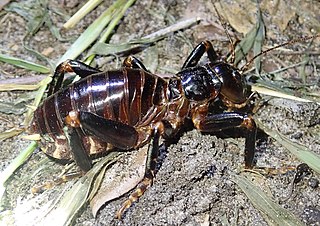
The Mount of Olives or Mount Olivet is a mountain ridge in East Jerusalem, east of and adjacent to Jerusalem's Old City. It is named for the olive groves that once covered its slopes. The southern part of the mount was the Silwan necropolis, attributed to the elite of the ancient Kingdom of Judah. The western slopes of the mount, those facing Jerusalem, have been used as a Jewish cemetery for over 3,000 years and holds approximately 150,000 graves, making it central in the tradition of Jewish cemeteries. Atop the hill lies the Palestinian neighbourhood of At-Tur, a former village that is now part of East Jerusalem.

The Virginia Range is a mountain range of western Nevada, primarily within Storey County, and extending east into Lyon County. The range is named after James Finney, "Old Virginny", an early discoverer of gold associated with the Comstock Lode.

The family Gryllidae contains the subfamilies and genera which entomologists now term true crickets. Having long, whip-like antennae, they belong to the Orthopteran suborder Ensifera, which has been greatly reduced in the last 100 years : taxa such as the spider-crickets and allies, sword-tail crickets, wood or ground crickets and scaly crickets have been elevated to family level. The type genus is Gryllus and the first use of the family name "Gryllidae" was by Francis Walker.

Stenopelmatus is one of two genera of large, flightless insects referred to commonly as Jerusalem crickets. They are primarily native to Central America, and one species is known from Ecuador.

Ensifera is a suborder of insects that includes the various types of crickets and their allies including: true crickets, camel crickets, bush crickets or katydids, grigs, weta and Cooloola monsters. This and the suborder Caelifera make up the order Orthoptera. Ensifera is believed to be a more ancient group than Caelifera, with its origins in the Carboniferous period, the split having occurred at the end of the Permian period. Unlike the Caelifera, the Ensifera contain numerous members that are partially carnivorous, feeding on other insects, as well as plants.

Kidron Valley is the modern name of the valley originating slightly northeast of the Old City of Jerusalem, which then separates the Temple Mount from the Mount of Olives, and ending at the Dead Sea. Beyond Jerusalem it continues in a general south-easterly direction through the Judean desert in the West Bank, reaching the Dead Sea near the settlement of Ovnat, and descending 4,000 feet (1,200 m) along its 20-mile (32 km) course.

Thomas Lockyer was a famous English cricketer during the game's roundarm era. He was one of the outstanding wicket-keepers of the 19th century.

Ammopelmatus is a genus of insects in the family Stenopelmatidae, one of two genera of large, flightless insects referred to commonly as Jerusalem crickets. They are native to western United States and northwestern Mexico.

Ammopelmatus muwu is a species of insect in family Stenopelmatidae. It is endemic to parts of San Luis Obispo and Santa Barbara counties in the United States state of California.
Ammopelmatus cahuilaensis is a species of insect in the family Stenopelmatidae. The species is found in the Coachella Valley and was described by Ernest R. Tinkham in 1968, in The Great Basin Naturalist.
Ammopelmatus navajo, commonly known as the Navajo Jerusalem cricket, is a species of nocturnal Jerusalem cricket in the family Stenopelmatidae. It is endemic to the United States, specifically Arizona, and found under rocks in loose soil. It is closely related to A. fuscus and they have nearly identical drumming patterns. They live one to two years as adults, but can die prematurely by parasitic infections, commonly by the horsehair worm.
Ammopelmatus nigrocapitatus is a species of insect in the family Stenopelmatidae. It is endemic to parts of Southern California.

Gryllacrididae are a family of non-jumping insects in the suborder Ensifera occurring worldwide, known commonly as leaf-rolling crickets or raspy crickets. The family historically has been broadly defined to include what are presently several other families, such as Stenopelmatidae and Rhaphidophoridae, now considered separate. As presently defined, the family contains two subfamilies: Gryllacridinae and Hyperbaeninae. They are commonly wingless and nocturnal. In the daytime, most species rest in shelters made from folded leaves sewn with silk. Some species use silk to burrow in sand, earth or wood. Raspy crickets evolved the ability to produce silk independently from other insects, but their silk has many convergent features to silkworm silk, being made of long, repetitive proteins with an extended beta-sheet structure.

Jerusalem crickets are a group of large, flightless insects in the genera Ammopelmatus and Stenopelmatus, together comprising the tribe Stenopelmatini. The former genus is native to the western United States and parts of Mexico, while the latter genus is from Central America.

Crickets are orthopteran insects which are related to bush crickets, and, more distantly, to grasshoppers. In older literature, such as Imms, "crickets" were placed at the family level, but contemporary authorities including Otte now place them in the superfamily Grylloidea. The word has been used in combination to describe more distantly related taxa in the suborder Ensifera, such as king crickets and mole crickets.

Grylloidea is the superfamily of insects, in the order Orthoptera, known as crickets. It includes the "true crickets", scaly crickets, wood crickets and other families, some only known from fossils.

Uxbridge Moor is a nature reserve managed by the London Wildlife Trust in Uxbridge in the London Borough of Hillingdon. It is a Site of Metropolitan Importance for Nature Conservation.
Ammopelmatus mescaleroensis is a species of Jerusalem cricket in the family Stenopelmatidae. It is found in the area around Mescalero, in the United States state of New Mexico.

Stenopelmatinae is the sole subfamily in the family Stenopelmatidae. There are about 7 genera and more than 50 described species in Stenopelmatinae.
Ammopelmatus longispina is a species of Jerusalem cricket in the family Stenopelmatidae. It is found in North America.















